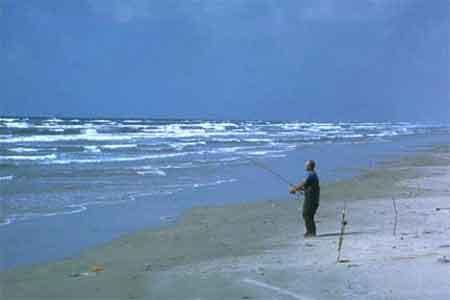Officials at Padre Island National Seashore are cautioning visitors about the occurrence of the natural phenomenon known as "red tide." The situation is causing a significant fish kill and officials are warning visitors about possible hazards to people and pets.
According to information from the park,
Red tide is a naturally occurring, higher-than-usual concentration of the microscopic algae Karenia brevis. The algae produce a toxin that affects the central nervous system of fish, so that they are paralyzed and cannot breathe. As a result, Red Tide blooms often result in dead fish washing up on the beach.
When red tide algae reproduce in dense concentrations, or "blooms," they are sometimes visible as discolored patches of ocean water, often reddish in color. High concentrations of microscopic algae in the rough surf can cause the irritants to become suspended in the salt spray when the waves break. Red Tide affects people and pets which are near the seashore.
Superintendent Joe Escoto asks park visitors to be cautious, especially children and visitors with breathing problems, as Red Tide can irritate the respiratory system, eyes and throat.
Thousands of dead fish have washed ashore in the park due to the red tide situation. If you're planning a visit to the park, you can phone the Malaquite Visitor Center at (361) 949-8068 for more information.
Information posted today on the Texas Parks and Wildlife Department (TPWD) website provides some details about the area involved in the current algae bloom:
TPWD hitched a ride aboard a U.S. Coast Guard helicopter yesterday to get an aerial view of the red tide bloom. The helicopter flew from Mustang Island to Port Mansfield and confirmed that both the bloom and patches of dead fish stretch along that entire length of coastline. On the northern end, the bloom is fairly close to the beach, approximately one-quarter mile offshore. An extensive offshore bloom was seen near Yarborough Pass along with many large fish floating in the area.
The TPWD also provided the following information from yesterday afternoon:
Cameron County game wardens working approximately 2 miles offshore of South Padre Island today report severe aerosol effects and many dead fish floating in the water.
Preliminary numbers from the Padre Island National Seashore fish kill indicate that the event is mostly comprised of mullet, Atlantic bumper and ladyfish (skipjack) with large redfish being seen as well. Fish were highly concentrated along the shoreline, numbering as high as 1000 fish in a 15-yard stretch.
Dead fish have also begun washing ashore in the Bob Hall Pier area, including ladyfish (skipjack), eels, and speckled trout. Discolored water can be seen out near the third sandbar.
Dead fish began washing ashore at Mustang Island State Park this afternoon. Aerosols were also reported. TPWD biologists will be on the beach Thursday morning to assess the fish kill.
The Texas Parks and Wildlife website and the site for the Centers for Disease Control and Prevention have additional information about red tide, including answers to frequently asked questions about hazards to human health and whether it is safe to eat fish and shellfish from areas affected by a current algae bloom.


 Support Essential Coverage of Essential Places
Support Essential Coverage of Essential Places







Comments
It is really too bad that people do not heed to the warnings that are being posted. Worse, they tend to blame management when something happens to them or their pet. Karenia brevis is serious folks. Pay attention to the warnings.